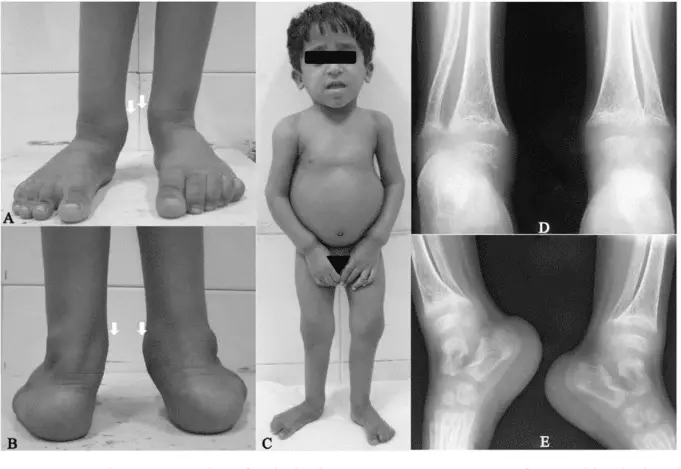Rickets is a childhood skeletal disorder that is caused by a deficiency of vitamin D, phosphate or calcium. These nutrients play vital roles in the development and maintenance of strong and healthy bones.
This disorder leads to weakening and softening of the bones, stunted growth and in extreme cases, skeletal deformities.
Vitamin D is an essential nutrient that helps your body absorb phosphate and calcium from your intestine. Your body produces this nutrient from being exposed to sunlight. Alternatively, Vitamin D can also be gotten from food sources like fish, milk and egg.
Insufficient vitamin D makes it difficult for your body to absorb and maintain proper levels of phosphate and calcium.
When this happens, your body releases hormones that start absorbing calcium and phosphate from your bones. Your bones become soft and weak once they start lacking these nutrients.
Who is at risk of developing rickets?
Rickets mostly affects children within the age of 6 to 36 months. Children are more prone to developing this disorder as they’re still growing. However, adults get affected by rickets but in a condition known as osteomalacia.
Children may develop a deficiency of vitamin D if:
- They live in a region with little sunlight
- They don’t drink dairy products
- If they’re on a vegetarian diet
Sometimes, a vitamin D deficiency may be hereditary.
Rickets remains a rare condition in the United States and other developed countries due to the production of fortified foods with added vitamin D, such as cereals.
What are the symptoms of rickets?
The signs and symptoms of this condition include
- Tenderness or pains in the bones of the spine, pelvis, legs and arms
- Bone fractures
- Muscle cramps
- Short stature or stunted growth
- Teeth deformities, including
- Abscesses
- Delayed tooth formation
- Defects in the tooth structure
- Holes in the enamel
- Higher amounts of cavities
Skeletal deformities, such as
- A curved spine
- Knocked knees or Bowlegs
- Pelvic deformities
- Irregularly shaped skull
- breastbone and ribcage abnormalities
Seek medical assistance immediately if your child starts developing signs of rickets. If the disorder isn’t treated during the child’s growing stage, the child may grow up to have very short stature.
If left untreated, the deformities can become permanent.
How is rickets diagnosed?
Diagnosis involves performing a physical examination on the child. Your doctor will check for pain or tenderness in the bones by gently pressing on them.
To confirm a diagnosis, your doctor may carry out some tests as well. They include
- Blood tests: this help measure the amount of calcium and phosphate in the blood and also look out for high amounts of alkaline phosphatase.
- Bone x-ray: this can help alterations in the skeletal structure or calcium loss in the bones.
- Arterial blood gas test: this looks for acidity in the blood.
- Bone biopsy: though doctors rarely use this procedure, it is also useful in confirming rickets. The process involves extracting and sending a tiny portion of bone to a lab for analysis.
What are the treatments for rickets?
Rickets treatment involves increasing the individual’s intake of the missing minerals or vitamins in the body.
Depending on the cause of the disorder, your doctor may suggest you take vitamin D supplements.
They may also suggest:
- Taking fish oil
- Making some dietary changes
- Consuming calcium and phosphate
- Getting enough sun exposure
- Dietary measures
- If a poor diet causes the condition, your doctor may recommend;
- Daily intake of vitamin D and calcium supplements
- An annual vitamin D injection (if the child is unable to take oral supplements)
- Formulating a diet plan that centres on foods rich in vitamin D
Vitamin D can also be obtained from the following foods
- Beef liver
- Cod liver oil
- Eggs
- Oily fish, such as tuna, sardines, swordfish, and salmon
- Vitamin D fortified foods, including milk, many kinds of cereal, some juices, some soy milk products and some brand of margarine.
Spending more time outdoors and making some dietary changes can help prevent rickets in most children.
Treating medical causes
When rickets results from an underlying medical condition, such as kidney disease, rickets may be prevented by treating the cause.
If the condition is hereditary, your doctor may recommend taking calcitriol and phosphate supplements to reduce bowing in the legs.
What are the expectations after rickets treatment?
The disorder can be corrected by increasing levels of calcium, phosphate and vitamin D in the body. Most cases of rickets start improving within one week of treatment.
Skeletal deformities may improve or disappear over time if the condition is treated while the child is still growing. However, the deformities can become permanent if rickets isn’t treated while the child is still young.
How can rickets be prevented?
Most times, you can prevent rickets by eating a diet that contains adequate amounts of vitamin D, calcium and phosphorus.
People with kidney conditions should have their phosphate and calcium levels Checked by their doctors regularly.
Other preventive measures include increased exposure to sunlight. The National Health Service of England (NHS) mentioned that you only need to expose your face and hands to sunlight a few times a week during the summer and spring months to prevent rickets.
Most adults get enough sun exposure. However, staying too long in the sun can damage your skin, so sunscreen should be used to prevent burns and skin damage.
However, sunscreen can sometimes prevent your skin from producing vitamin D, so it’s beneficial that you consume foods that are packed with vitamin D or to take vitamin D supplements.
The risk of developing rickets can be minimised significantly by strictly adhering to these preventive measures.













